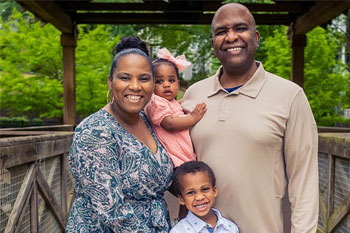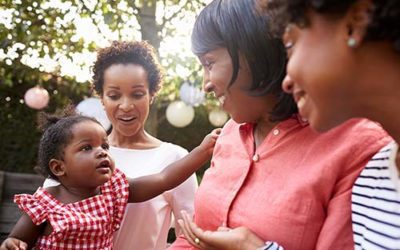
By bringing a new child into the home, your dog may feel overwhelmed, confused, and stressed. There will be a baffling array of new scents and sights to deal with. And your schedule will change to accommodate your new family member.
That means Fido’s schedule will change, too. If they’re used to being the center of your world, they may be confused by the sudden drop in attention.
Dogs can suffer from strong emotions such as jealousy and depression when a new child arrives. Fortunately, there are some simple steps to ensure your pooch’s emotional needs are met.
This process has three simple steps:
- Consider how your lives will change.
- Teach your dog new skills
- Prepare your dog for new life experiences
How Your Lives Will Change and How to Introduce Your Dog to a New Baby
Look at the day-to-day lives of everyone in your home. Consider how each person’s schedule will change. It’s essential to be honest. For example, telling yourself your dog will receive the same amount of attention after your adoption isn’t realistic.
A life-altering decision to bring a new child into your home is a big change. It’s a welcome one, but it will cause a significant shift. How will these changes affect other members of your family? How will the addition of a new family member affect your finances?
This change in your life may cause anxiety you weren’t anticipating. One option to lower your stress levels is to register your dog as an emotional support animal. Since dogs are task-driven, they will enjoy having a “job.” It may benefit you both. And getting an ESA letter is easier than ever.
Working to ensure everyone’s emotional health is a crucial step since everyone in your home will be affected. All these changes in the lives of the people will affect your dog, too. Dogs tune into the energy of the people around them.
How will these schedule changes affect your dog? How will their life be different? What skills will your dog need? What (if any) safety concerns are there? Once you’ve taken an in-depth look at how your lives will change, it’s time to teach your dog some basic skills to make the transition easier for all.
Teach Your Dog New Skills
Since the adoption process can take six months (or more) before you bring your baby home, you’ll have time to get your dog ready for the big day.
To teach your dog new skills, enroll them in obedience classes. They will give them a sense of purpose and make balancing their doggie behaviors and the needs of your new child easier. To prepare for your child’s arrival, your dog should know the following commands:
- Sit – This simple command is the cornerstone of all good dog behavior.
- Drop it – Knowing this command prevents Fido from running off with baby toys.
- Lie down – This lets your dog stay in the room with your baby. If they can stay in the room, they won’t have as much separation anxiety.
- Go away – This term might sound a bit rude, but it’s a valuable skill to teach your dog. Teaching your dog to go away gives them the option of leaving the situation.
- Crate train – Too often, people think of a dog’s crate as punishment or for “time out.” Crate training your dog gives him a place to go when things get crazy in your house and can ease their stress.
Prepare Your Dog for New Life Experiences
Dogs typically don’t like change in their lives. Moving into a new home confuses them because all their physical surroundings have changed. New family members and schedule changes are stressful too.
You should have plenty of time to help both you and your dog adjust. If you’re considering registering your dog as an emotional support animal, start the process early in the adoption plans. It will reduce your to-do list later.
Start by bringing new objects associated with your baby to your dog. Let him sniff them to get used to the scents. Then, condition him to associate those new smells with you.
Supervise All Encounters
One of the most important things we can tell you about how to introduce your dog to a new baby is to supervise all encounters. Depending on the age of your adopted baby, they may be too young to know right from wrong. A toddler who reaches for your dog and pokes him in the eye is not being cruel. They’re just exploring the world around them. Children are ‘hard-wired’ at birth to be explorers.
A baby’s actions can’t be entirely predicted. And neither can a dog’s. Even with the most effective training and preparation available, Fido might do something completely unexpected. So keep close to both your child and your dog when they’re together, especially in the early stages.
This is a big tip: When your baby is with you, give your dog lots of attention. Give him praise. Pet him while holding your baby. Help him learn to associate positive things with the baby.
Depression vs. Illness or Injury
Even if you’ve prepared your dog to the best of your ability, they may still have trouble adjusting and show signs of anxiety. However, dogs often show signs of anxiety when they are sick or injured. The trouble is, Fido can’t tell you if they’re feeling sick or just bummed out.
Veterinarians always recommend getting your pooch in for a checkup if their behavior changes. Since unusual behavior may point to something physically wrong, it’s best to find out for sure.
Enjoy the Future with Your New Baby and Your Dog
With all of this information about how to introduce your dog to a new baby, remember that adopting a new baby is a joyous experience. Your life is about to change in ways you probably can’t predict. All of this is wonderful and amazing. By making sure to address your dog’s emotional needs, they can take part in the joy, too.
Heidi Keefer is a Content Creator for Lifetime Adoption and has over 15 years of experience in the field of adoption. An author of thousands of articles and social media posts over the years, Heidi enjoys finding new ways to educate and captivate Lifetime’s ever-growing list of subscribers.
Heidi has a keen eye for misplaced apostrophes, comma splices, and well-turned sentences, which she has put to good use as a contributor to Lifetime’s award-winning blogs. She has written and published hundreds of adoption articles which explore the various facets of domestic infant adoption today.





0 Comments